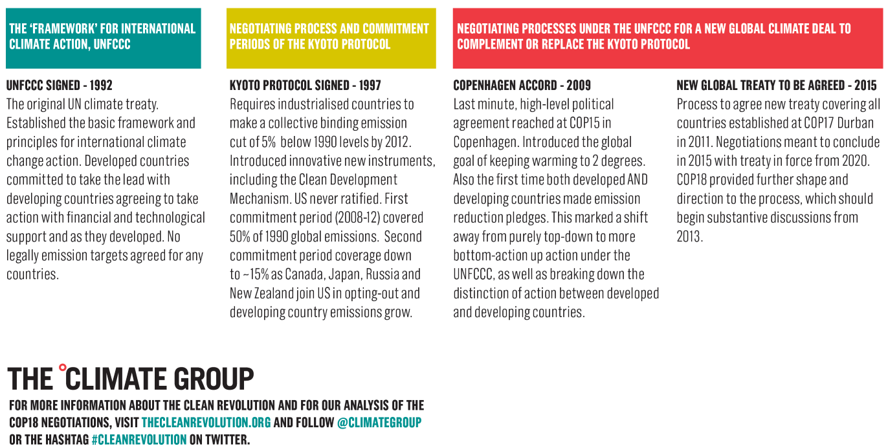Before we can dig into where things stand with the Paris Agreement or how likely it is to be successful moving forward, we need to take a stroll through the history of international (and eventually global) scale efforts to address climate change. We'll see that this is much more of an evolutionary process than a revolutionary one. First, a few important terms to note moving forward are:
- IPCC: Intergovernmental Panel on Climate Change. This was created in 1988 with the intent "to provide policymakers with regular scientific assessments on the current state of knowledge about climate change and to prepare a comprehensive review and recommendations with respect to the state of knowledge of the science of climate change; the social and economic impact of climate change, and potential response strategies and elements for inclusion in a possible future international convention on climate," according to the United Nations. Essentially, this is the body that oversees all UN-sponsored climate-related research, or as they put it: "IPCC assessments provide a scientific basis for governments at all levels to develop climate related policies, and they underlie negotiations at the UN Climate Conference" (source: IPCC). See more about who they are here and what they do here. The IPCC provides the Assessment Reports and interim reports.
- UNFCCC: the United Nations Framework Convention on Climate Change. This was created in 1992 and is headquartered in Bonn, Germany. They perform a key role in international climate negotiations and are in fact the body that facilitated all major international agreements, including the Kyoto Protocol and the Paris Agreement. They manage the Nationally Determined Contributions (NDCs), which are the most consequential aspect of the Paris Agreement. They have full-time staff that host 2-4 negotiating sessions a year where they hash out issues related to the international climate negotiations. The most anticipated of these meetings is the Conference of Parties (see below). See this summary of what the UNFCCC does from the UN.
- COP: Conference of Parties. This is the primary decision-making body of the UNFCCC. They meet every year, and include tens of thousands of participants (you can find a list of COPs here along with associated reports). The term COP is mostly used to refer to these annual meetings. The COPs are where they formally hash out international climate negotiations. The COPs result in reports on the progress of negotiations, though sometimes result in major agreements such as the Kyoto Protocol (COP 3 in Kyoto, Japan) and the Paris Agreement (from COP 21 in Paris, France).
- AR: Assessment Report. Reports promulgated every ~5 years by the IPCC. They provide meticulously researched details about emissions, their impacts, and more. They summarize all relevant climate-related information under the IPCC purview. The reports are highly anticipated by global policymakers working on climate change-related policies. The most recent report was released in 2022, with the full Assessment Report (AR6) released in 2023. Each report is numbered - AR1 was in 1992, AR2 was in 1995, and so on.
- INDCs and NDCs. Intended Nationally Determined Contributions and Nationally Determined Contributions. INDCs form the core of the Paris Agreement. Each country submitted its INDCs to detail how it would achieve their emissions reduction goals per the Agreement. Essentially, it is their plan to reduce emissions. After each country formally entered the Agreement, INDCs were referred to as NDCs. These are updated periodically, usually around every 3-5 years. The details in NDCs vary widely among countries. (More on this later.)
This infographic (which I broke into two separate pieces to make it easier to consume) was put out by The Climate Group around the time the Paris Agreement was forged. I can't find an active link for it on their site anymore, but I think it does a nice job of breaking up our decades of work on this problem to show the very slow pace at which things have moved historically and where the important jumps are in terms of how we think about tackling this problem. Let's take a look. (Please note that the terms "developed" and "developing" countries are used by the UN for these reports, and so will be used in the lesson as well.)
Evolution of policy options
- When the UNFCCC was created in 1992, it 1) represented a much smaller subset of countries and 2) only encouraged voluntary actions.
- As the Kyoto Protocol started to develop, the UNFCCC started to establish binding targets for the developed countries but only had voluntary targets for undeveloped countries. (This ends up causing a lot of blame-game between the developed and developing economic powerhouses - in particular US vs China.)
- One of the takeaways of the Kyoto Protocol that we all need to be in this truly together. And so the Paris Agreement marks the first time that we're all in, and we're all beholden to targets. The difference? Countries get to set these targets themselves. (One aspect that has remained consistent is that there are no penalties for not reaching annual or long-term targets.)
Imagine this image below is a clock. (Click on the image to access a resizable version that is easier to see.) If you look at about 1 pm, you see that in the late 1980s, the UNFCCC is established. It isn't until about 9 o'clock at that the Paris Agreement is adopted and here we stand somewhere around 10-11 o'clock or so, wondering where it will take us.


